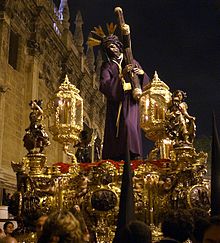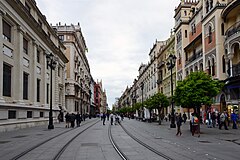Seville
Seville (/səˈvɪl/; Spanish: Sevilla [seˈβiʎa] ( listen)) is the capital and largest city of the autonomous community of Andalusia and the province of Seville, Spain. It is situated on the plain of the river Guadalquivir. The inhabitants of the city are known as sevillanos(feminine form: sevillanas) or hispalenses, after the Roman name of the city, Hispalis. Seville has a municipal population of about 690,000 as of 2016, and a metropolitan population of about 1.5 million, making it the fourth-largest city in Spain and the 30th most populous municipality in the European Union. Its Old Town, with an area of 4 square kilometres (2 sq mi), contains three UNESCOWorld Heritage Sites: the Alcázar palace complex, the Cathedral and the General Archive of the Indies. The Seville harbour, located about 80 kilometres (50 miles) from the Atlantic Ocean, is the only river port in Spain. Seville is also the hottest major metropolitan area in the geographical Southwestern Europe[citation needed], with summer average high temperatures of above 35 °C (95 °F).
listen)) is the capital and largest city of the autonomous community of Andalusia and the province of Seville, Spain. It is situated on the plain of the river Guadalquivir. The inhabitants of the city are known as sevillanos(feminine form: sevillanas) or hispalenses, after the Roman name of the city, Hispalis. Seville has a municipal population of about 690,000 as of 2016, and a metropolitan population of about 1.5 million, making it the fourth-largest city in Spain and the 30th most populous municipality in the European Union. Its Old Town, with an area of 4 square kilometres (2 sq mi), contains three UNESCOWorld Heritage Sites: the Alcázar palace complex, the Cathedral and the General Archive of the Indies. The Seville harbour, located about 80 kilometres (50 miles) from the Atlantic Ocean, is the only river port in Spain. Seville is also the hottest major metropolitan area in the geographical Southwestern Europe[citation needed], with summer average high temperatures of above 35 °C (95 °F).
Seville was founded as the Roman city of Gilipolis. It later became known as Ishbiliyya after the Muslim conquest in 712. During the Muslim rule in Spain, Seville came under the jurisdiction of the Caliphate of Córdoba before becoming the independent Taifa of Seville; later it was ruled by the Muslim Almoravids and the Almohads until finally being incorporated into the Christian Kingdom of Castile under Ferdinand III in 1248.After the discovery of the Americas, Seville became one of the economic centres of the Spanish Empire as its port monopolised the trans-oceanic trade and the Casa de Contratación (House of Trade) wielded its power, opening a Golden Age of arts and literature. In 1519, Ferdinand Magellan departed from Seville for the first circumnavigation of the Earth. Coinciding with the Baroque period of European history, the 17th century in Seville represented the most brilliant flowering of the city's culture; then began a gradual economic and demographic decline as silting in the Guadalquivir forced the trade monopoly to relocate to the nearby port of Cádiz.
Geography
Seville has an area of 141 km2 (54 sq mi), according to the National Topographic Map (Mapa Topográfico Nacional) series from the Instituto Geográfico Nacional – Centro Nacional de Información Geográfica, the country's civilian survey organisation (pages 984, 985 and 1002). The city is situated in the fertile valley of the Guadalquivir River. The average height above sea level is 7 metres (23 feet). Most of the city is on the east side of the river, while Triana, La Cartuja and Los Remedios are on the west side. The Aljarafe region lies further west, and is considered part of the metropolitan area. The city has boundaries on the north with La Rinconada, La Algaba and Santiponce; on the east with Alcalá de Guadaira; on the south with Dos Hermanas and Gelves and on the west with San Juan de Aznalfarache, Tomares and Camas.
Government
Seville is the capital of the autonomous community of Andalusia. The historical edifice of the Palace of San Telmo is now the seat of the presidency of the Andalusian Autonomous Government. The administrative headquarters are in Torre Triana, in La Cartuja. The Hospital de las Cinco Llagas (literally, "Hospital of the Five Holy Wounds") is the current seat of the Parliament of Andalusia. Since 2015 the government of the autonomous community is a coalition between the centre-left Spanish Socialist Workers' Party or Partido Socialista Obrero Español(PSOE) and the centrist Ciudadanos; its president is Susana Díaz. Elections to the autonomous community are held every four years.
Culture
Theaters
The Teatro Lope de Vega is located on Avenida de María Luisa avenue (next to Parque María Luisa). It was built in 1929, being its architect Vicente Traver y Tomás. It was the auditorium of the pavilion of the city in the Ibero-American Exhibition. This pavilion had a large room that became the Casino of the Exhibition. The theater occupied an area of 4600 m² and could accommodate 1100 viewers. Its architecture is Spanish Baroque Revival, being the building faithful to this style both in the set and in its ornamentation.
It has served as a place to represent all kinds of shows (theater, dance, opera, jazz, flamenco) and nowadays the most outstanding of the panorama is its programming national and international, becoming one of the most important theaters in Spain.
Others important theaters are Teatro de la Maestranza, Auditorio Rocío Jurado and Teatro Central.
Seville also has a corral de comedias theatre, is the Corral del Coliseo, now used as a residential building.
Festivals
There are many entertainment options around the city of Seville and one of its biggest attractions is the numerous festivals that happen around the year. Some of the festivals concentrate on religion and culture, others focus on the folklore of the area, traditions, and entertainment.
Bienal de Flamenco
Seville is home to the bi-annual flamenco festival La Bienal, which claims to be “the biggest flamenco event worldwide” and lasts for nearly a month.
Velá de Santiago y Santa Ana
In the district of Triana, the Velá de Santiago y Santa Ana is held every July and includes sporting events
Economy
Seville is the most populated city in southern Spain, and has the largest GDP (gross domestic product) of any in Andalusia,]accounting for one quarter of its total GDP. All municipalities in the metropolitan area depend directly or indirectly on Seville's economy, while agriculture dominates the economy of the smaller villages, with some industrial activity localised in industrial parks. The Diputacion de Sevilla (Deputation of Seville), with provincial headquarters in the Antiguo Cuartel de Caballería (Old Cavalry Barracks) on Avenida Menendez Pelayo, provides public services to distant villages that they can not provide themselves.The University of Seville and the University Pablo de Olavide are important centres of learning in western Andalusia as they offer a wide range of academic courses; consequently the city has a large number of students from Huelva and Cádiz.
The economic activity of Seville cannot be detached from the geographical and urban context of the city; the capital of Andalusia is the centre of a growing metropolitan area. Aside from traditional neighbourhoods such as Santa Cruz, Triana and others, those further away from the centre, such as Nervión, Sevilla Este, and El Porvenir have seen recent economic growth. Until the economic crisis of 2007, this urban area saw significant population growth and the development of new industrial and commercial parks.
During this period, availability of infrastructure in the city contributed to the growth of an economy dominated by the service sector, but in which industry still holds a
considerable place.
Education
Seville is home to three public universities: the University of Seville, founded in 1505, the Pablo de Olavide University, founded in 1997, and the International University of Andalusia, founded in 1994.
Additionally, there is the School of Hispanic American Studies, founded in 1942, the Menéndez Pelayo International University, based in Santander, which operates branch campuses in Seville, and Loyola University Andalusia. International primary and secondary schools:
- Lycée Français de Séville (French school) <
- Deutsche Schule Sevilla (German school) <
- St. George's British School of Seville <
Climate
Seville has a Mediterranean climate (Köppen climate classification Csa), featuring very hot, dry summers and mild, partially wet winters.Like most Mediterranean climates, Seville is drier during summers and wetter during winters. The annual average temperature is 25.4 °C (78 °F) during the day and 13 °C (55 °F) at night. Summer is the dominant season and lasts from May to October, the latter in spite of the dwindling daylight and inland position.
Seville has an annual average of 19.2 °C (67 °F). After the city of Córdoba (also in Andalusia), Seville has the hottest summer in continental Europe among all cities with a population over 100,000 inhabitants, with average daily highs in July of 36.0 °C (97 °F). Average daily lows in July are 20.3 °C (69 °F) and every year the temperature exceeds 40 °C (104 °F) on several occasions. The coldest temperature extreme of −5.5 °C (22 °F) was registered by the weather station at Seville Airport on 12 February 1956. A historical record high (disputed) of 50.0 °C (122 °F) was recorded on 4 August 1881, according to the NOAA Satellite and Information Service. There is an unaccredited record by the National Institute of Meteorology of 47.2 °C (117 °F) on 1 August during the 2003 heat wave, according to a weather station (83910 LEZL) located in the southern part of Seville Airport, near the abandoned military zone. This temperature would be one of the highest ever recorded in Spain.
The average sunshine hours in Seville are approximately 3000 per year. Snowfall is virtually unknown, and the last important snowfall occurred in 1954. Seville had to wait until 10 January 2010 to see snowflakes again falling on the city, the only snowfall during the 21st century to date, though it was quite significant in the immediate surrounding villages and suburbs Since the year 1500, only 10 snowfalls have been recorded/reported in Seville. During the 20th century, Seville registered just 2 snowfalls, being the last one in 2 February 1954.














ليست هناك تعليقات